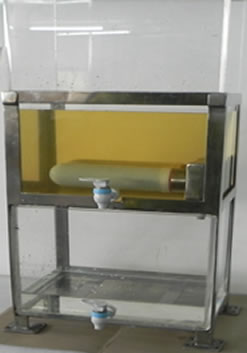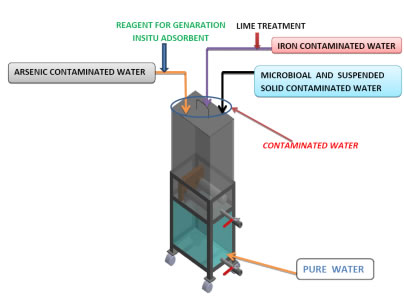

BARC has developed a methodology to produce a domestic water purification device which is made of polysulfone based nanocomposite ultrafiltration membrane in cylindrical configuration. This configuration device stand alone can be effective for removal of microbial contaminations and decontamination of arsenic and iron through chemical addition without the need of any electricity and overhead water tank, and hence can be used even in slums and rural areas of the country. The contamination level is reduced below the permissible limits as specified by IS 10500 for drinking water standard. This is very simple, well-engineered, single, reliable and cost effective point-of-use device.
Membrane separation processes have gained tremendous advancements in the recent past and continue to surge ahead as a frontier technology in the field of water purification. Nanotechnology, on the other hand, is increasingly being identified as an area of science and technology that could play a role in addressing some of the short-comings of conventional Point Of Use (POU) devices. Studies suggest that nanotechnology-based materials could lead to cheaper, more durable, and more efficient water treatment technologies that meet the needs of developing countries. Several water treatment methods and devices that incorporate nanoscale materials are being developed. However, it is realized that a well defined and well engineered nano-based POU water purification device for household should come into force to take care of safe-water needs of all sections of our society.
Bhabha Atomic Research Centre is extensively involved in development and deployment of desalination, water purification and water recycle technologies for providing safe drinking water to the masses. BARC has developed a methodology to produce a domestic water purification device which is made of polysulfone based nanocomposite ultrafiltration membrane in cylindrical configuration.
This configuration device stand alone can be effective for removal of microbial contaminations and decontamination of arsenic and iron in the states like West Bengal, Chhatisgarh, Bihar, Jharkhand, North Eastern states etc through chemical addition without the need of any electricity and overhead water tank, and hence can be used even in slums and rural areas of the country.
The device with two candles can provide 20 Liter per Day of potable water and the contamination level is reduced below the permissible limits as specified by IS 10500 for drinking water standard. This is very simple, well-engineered, single, reliable and cost effective point-of-use device.
Membrane separation processes have gained tremendous advancements in the recent past and continue to surge ahead as a frontier technology in the field of water purification. Nanotechnology, on the other hand, is increasingly being identified as an area of science and technology that could play a role in addressing some of the short-comings of conventional POU devices. Studies suggest that nanotechnology-based materials could lead to cheaper, more durable, and more efficient water treatment technologies that meet the needs of developing countries. Several water treatment methods and devices that incorporate nanoscale materials are being developed. However, it is realized that a well defined and well engineered nano-based POU water purification device for household should come into force to take care of safe-water needs of all sections of our society.
Bhabha Atomic Research Centre is extensively involved in development and deployment of desalination, water purification and water recycle technologies for providing safe drinking water to the masses. BARC has developed a methodology to produce a domestic water purification device which is made of polysulfone based nanocomposite ultrafiltration membrane in cylindrical configuration. This configuration/point-of-use device stand alone can be effective for removal of microbial contaminations and decontamination of arsenic and iron in the states like West Bengal, Chhatisgarh, Bihar, Jharkhand, North Eastern states etc through chemical addition without the need of any electricity and overhead water tank, and hence can be used even in slums and rural areas of the country. The device with two candles can provide 20 Liter per Day of potable water and the contamination level is reduced below the permissible limits as specified by IS 10500 for drinking water standard. This is very simple, well-engineered, single, reliable and cost effective point-of-use device.
RAW MATERIALS
INFRASTRUCTURE
MANPOWER

